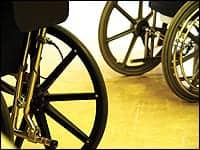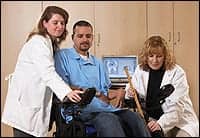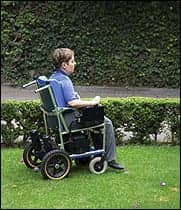 |
As therapists, we are required to stay informed about developments in the mobility industry. Helping patients make the best choices when choosing wheelchairs and other mobility equipment requires a need to know about new technology and product development, manufacturers’ information, and insurance reimbursement. Coupled together, it enables a comprehensive evaluation of a patient’s needs, environment, and physical presentation and consideration of the latest industry information before recommending the best product and technology to achieve mobility goals.
It is important to note that equipment options change on a regular basis. At Good Shepherd Rehabilitation Network in Allentown, Pa, patients undergo a comprehensive wheelchair and seating assessment when looking for new equipment—particularly when what they have used in the past is no longer available. They will not be able to replace their old chair with the same model in many cases, so the assessment is important to meet their needs and to ensure that seating and positioning are fit correctly.
|
It would appear that the last 6 months has been one of the slowest periods in recent history for new product development in the mobility industry. Manufacturers have traditionally introduced new innovations or improvements to existing products about every 6 months. During a recent visit to a consumer trade show for mobility products, there were few new developments. A sluggish economy and constraints or changes in reimbursement are affecting how quickly manufacturers are bringing new products to market and are influencing the kinds of products and changes that are being introduced.
INDUSTRY TRENDS
Overall, manufacturers are striving to build their wheelchairs to be as adaptable and adjustable as possible to maximize the life and usage of the wheelchair. This is advantageous for the user because—with constraints and changes to reimbursement—they do not need to navigate the approval process to get a whole new chair. The most significant trend for seating has been the introduction of repositionable seats on wheelchairs. Previously, most chairs were produced with an 18-inch by 18-inch seat. Now, more wheelchairs for both adult and pediatric patients are being built with options for seat growth to maximize the life of the chair.
 |
| The authors, Amy Kirkner, MPT, ATP, and Patti Dworak, MSOT, OTR/L, ATP, with a client. |
With these new adaptations, the seat is repositioned in one of two ways: Some chairs automatically come with a new cross brace and a new seat sling. The frame telescopes to readjust the size of the seat. Other chairs come with a one-time free growth kit that can be requested from the manufacturer. The kit includes the parts needed to adjust the seat. Patients do not have to buy a new chair because of a child’s growth spurt, or weight gain or loss due to medication or other physical changes among adults. With the ability to adjust the seat for growth, the need to replace the chair is reduced.
Safety issues are having a significant impact on product development. One option offered more frequently on both power and manual wheelchairs is transportation brackets. Previously, only a few manufacturers offered them. Now they are available from most manufacturers. This change is being driven by requests from school districts and other organizations that transport wheelchair users. They want to see wheelchairs secured when individuals are transported.
Although new developments in drive controls have been few, more options are likely. Having as many driving options as possible continues to be important to people. In addition, upgrades and changes to the electronics that drive the chair will be welcome as they develop.
REIMBURSEMENT AND PRODUCT DEVELOPMENT
Reimbursement issues are playing a more significant role in product development in the mobility industry. Manufacturers seem to be more focused on insurance restrictions when offering new equipment or features. Meeting insurance guidelines is a primary objective. Wheelchair and wheelchair part requests are generally coming under greater scrutiny by insurance companies. The companies are requesting more detailed information as well as medical consults and home evaluations. Manufacturers are anticipating the needs of insurance companies as they eliminate some products and introduce others.
 |
| An uncertain economy has slowed the introduction of new mobility products. |
There have been drastically reduced options in portable (break-apart) wheelchairs—a change that seems directly attributable to difficulty in obtaining reimbursement for these chairs. The portable chairs were very desirable for patients who need to get out and about for everything from physician appointments and physical therapy to family outings and trips to the store. However, reimbursement focuses on paying for equipment that is used in the home—which is deemed a medical necessity.
Reimbursement issues contributed to one innovative new product being withdrawn from the market. Independence Technology discontinued the manufacture of its iBOT 4000 mobility system. The iBOT, with its sophisticated internal computer technology, enabled individuals to climb stairs, navigate uneven terrain and curbs, and rise up (while seated) to reach high shelves and counters. It was a leading-edge solution for individuals who wished to remain in their homes and who did not have the means or desire to move to a house that is not wheelchair accessible. However, insurance companies classified it as a Class 3 medical device instead of a wheelchair–a classification that made it more difficult to qualify for reimbursement. The company has committed to provide user support through 2013 for those who had already purchased the product.
As companies adjust product development based on reimbursement issues, the impact to the end user is twofold: There are fewer product options in some product categories, and patients are finding it more difficult to be reimbursed for equipment that meets their needs. For example, most insurance companies are no longer paying for portable power wheelchairs or for a second cushion cover—both product options that are valuable to the end user for practical reasons.
Clinicians have a role in helping patients resolve insurance issues. Patients should be evaluated at an approved and reputable wheelchair clinic to make sure all their seating and functional mobility needs are being met. Choosing such a clinic also improves their chances for receiving reimbursement. Good Shepherd is an approved clinic for patients insured by medical assistance or Medicare, or supported by the Office of Vocational Rehabilitation. Clients served by those programs should begin by finding an approved facility. This also will ensure that they have an educated advocate—their therapist—to assist with insurance appeals, if necessary. It should be noted that patients also should choose a reputable durable medical equipment vendor who works with a variety of insurance offerings.
Good Shepherd’s policy is to complete a letter of medical necessity outlining and justifying the need for any and all equipment. In it, there is an outline of medical necessity, as well as an outline of the patient’s challenges of daily living and it may even include records of physician visits where the need for a mobility device has been discussed.
Clinicians should be willing and become experienced in participating in the appeals process. Therapists should educate their patients about the next steps if they receive a denial from their insurance company. The therapist can then craft an addendum to provide any information that the insurance company is requesting.
THE MOBILITY INDUSTRY AND THE ECONOMY
In today’s economy, there are concerns about companies going out of business. Fortunately, patients do not need to worry about whether their mobility equipment goes out of business because mobility equipment companies are similar to the auto industry: They have to supply parts for 7 years after discontinuing a product. Since the normal life expectancy of a wheelchair is 5 years, individuals can expect to have their chair maintained for its life expectancy, even if the manufacturer ceases operation.
In general, the effect of the economy on individuals is far greater than it is on manufacturers. With spiraling costs for everything from food to health care, it is becoming more difficult for them to pay out-of-pocket expenses. In addition, many individuals have lost jobs in this economy—and find themselves without medical insurance. Paying for needed mobility equipment without insurance—or a steady income—is challenging. It is a situation that is recurring with alarming frequency.
There are alternative avenues for funding or securing needed mobility equipment in the absence of insurance. Therapists should familiarize themselves with these groups and be prepared to identify ones that might help a patient who needs assistance. A list of organizations that can help individuals with equipment needs is an essential resource. The therapist can be a patient’s partner and advocate in getting needed equipment. Staying informed and current about changes in equipment, manufacturers, and reimbursement can ensure that therapists are ready to give the expert advice that they need.
Amy Kirkner, MPT, ATP, is a staff therapist and wheelchair clinic coordinator, and Patti Dworak, MSOT, OTR/L, ATP, is a staff therapist at Good Shepherd Rehabilitation Network’s Wheelchair Clinic, Allentown, Pa. For more information, contact .




